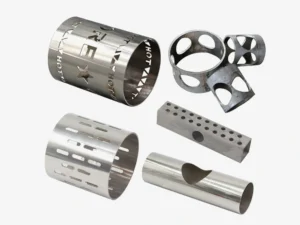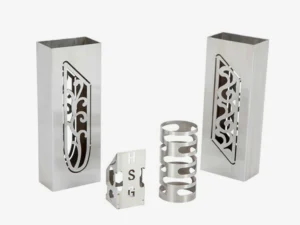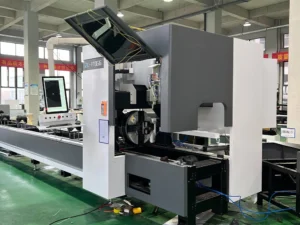Introduction:
A perforated tube is critical to drainage, filtration, and granary ventilation. It generally has many holes on the curved surface and may be used in factories, machinery, or household appliances.
Mechanical methods make making tiny holes in a tube difficult. Laser tech allows you to make small holes in these pipes. The high-quality cut ensures perfect perforated tubes. Let’s learn more about them.
What is a Perforated Tube?
Perforated means pierced with a hole or holes. Consequently, a perforated tube means regular pipes with holes or holes. The holes may be either evenly or unevenly distributed. The shape and number of holes depend on the project’s specific design.

The openings or holes vary in size, shape, and pattern. Some common perforation patterns are round, slotted, square, and custom.
Perforated tubes are used in many situations. They are primarily used for filtration, separation, and fluid flow control.
Let’s imagine an example. Are you familiar with drainage systems? They are an excellent place where we use perforated tubes a lot. They mainly facilitate water flow and prevent clogging. The tube, embedded in gravel or garbage, allows water to seep through the holes. In this way, it helps drain the water and block debris.
Various types of materials are used to make perforated tubes. But in most cases, people like to use metals. Stainless steel, aluminum, carbon steel, copper, brass, and titanium are the most common. Plastics are also sometimes used in various tubes.

Perforations are common in other objects, such as angles, channels, or boxes. Using the same technology, you can create holes in any enclosed or semi-closed object.
At ZL Tech, you can get different types of tube laser cutting machines. The best part of these machines is their capabilities. You can cut longer or shorter pipes. Before deciding, always discuss it with their engineers.
Various Applications of Perforated Tube
A perforated tube filters liquids and air from a source. It can be used in the food, medicine, and chemical industries. It simply serves as a sieve, separating materials and removing contaminants. That’s why perforated tubes are crucial for product quality and safety.
Another job of a perforated tube is to act as a structural support. It mainly holds various filter elements together.
Besides, the perforated tube helps reduce noise. Because of this, people often use it in acoustic systems to weaken and diffuse sound waves.
Finally, the perforated tube is also crucial in granary ventilation. It makes airflow easier and keeps storage conditions at their best. You may often see this use in agriculture settings.
How to Make a Perforated Tube with a Tube Laser Cutting Machine?
Laser cutting machines are automatic. So, you will need some basic skills on how a laser cutting machine for tubes works. Always adhere to specific steps to ensure the cut is of the best quality.
The instructions are the same whether you make perforated square tubing, perforated steel tubing, or any other perf tube. You only need to change the design and coding parameters.
Step #1 Preparation
First, select the appropriate material for the process. Always ensure the material is compatible with the laser device. Common materials used in this case are SS, CS aluminum, or brass. You should also consider the thicknesses. Most ZL Tech tube laser cutting machines can handle thicknesses from 5mm to 25mm.
Try to clean the pipe or tube before cutting it. Contamination can hamper the quality of the cut. Besides, check your laser device’s safety mechanism, ventilation, and rotary fixtures.
Step #2 Design & Simulation
This is the most crucial step of the whole process. Since you will cut a cylindrical object, thus your design must be precise. People usually use CAD software like AutoCAD, SolidWorks, or Fusion360. You can also design using software like Lightburn, laserGRBL, or Illustrator. Although laserGRBL gives you limited options for designing.
You can also simulate your design in simulation software. Simulation helps you predict the quality of the final products and identify issues. You can then take the necessary steps to solve the problems or change the design.
Step #3 Setting Up the Machine
Once the design is ready, set up your machine correctly. When dealing with cylindrical objects, you must ensure two things. Position the rotary fixture correctly so the laser beam can cut the pipe accurately. Next, adjust the focal length of the laser.
Now, calibrate your machine. Check the height of the laser gun. Then, position the tube and securely attach it to the rotary fixture. If the tube is long, check all the support equipment that holds it. Then, correctly position the laser’s red mark on the pipe’s surface.
Once the set-up and calibrations are done, adjust the laser settings. Remember that the laser parameters depend on the type of material and design. In this case, always seek professional assistance. You can also contact the ZL Tech customer support team to learn the different parameters of laser settings for various materials.
Step #4 Test Cut & Adjust Parameters If Necessary
Before proceeding to the final steps, perform a test cut. This step ensures the perforated tube is in good shape. You can adjust the laser parameters to get the best results if necessary.
Step #5 Perforating Tube with Tube Laser Cutting Machine
After successful test cuts and parameter adjustments, you can proceed with production. Your laser pipe-cutting machine will follow the designed pattern accurately. The speed, in this case, depends on the thickness of the material. However, following the codes, your tube laser cutting machine will create clean and accurate holes in the perforated tube.
When the perforation is in process, constantly monitor it. If you see any signs of issues, take the necessary steps. If it poses safety risks, press the emergency button for safety.
Step #6 Post-processing Tasks
Finally, this step may include additional processes. For example, you may need to remove burrs or sharp edges. For certifications, you may have to test the tube for defects. However, other treatments may also be necessary. It generally depends on specific situations.
Other Traditional Methods of Making Perforated Tubes
You can also create perforated tubes using other methods. As you know, tube laser cutting gives you precision, speed, and versatility. It also produces less waste. However, all these benefits might be absent in other methods of making perforated tubes.
Mechanical Punching
This process generally uses a punch and die set to create holes in the tubes. It is relatively faster for large batches but limited to simple patterns.
Mechanical punching is also a cost-effective method. However, the pressure exerted by the machine may deform the tube.
Drilling
This process uses a drill bit to create circular holes. Drilling is flexible for various hole sizes, mainly depending on the diameter of the drill bit.
However, it’s a slow process for high-volume production. Moreover, it is less accurate.
CNC Milling
This process uses a computer-controlled mill to cut holes. CNC milling is also accurate, but it takes a lot of time. However, you can create complex patterns, adding an extra cost.
Why Choose Tube Laser Cutting Machine?
Why is laser technology better than the three other methods mentioned above? To find out, we need to consider four critical factors reasonably.

The tube laser cutting machine is fast and accurate. You can create nearly hundreds of holes in a minute. This quick feature usually reduces production time and material waste. Overall, the tube laser cutting machine gives the most efficient solution.
The next factor is versatility. The laser beam generally works on many materials. Also, you don’t even need to change tools like drilling or punching methods. This flexibility reasonably allows you to meet diverse customer needs.
The third factor is the cut quality. As you know, a tube laser cutting machine works by hitting with a highly focused laser beam. It only cuts the area it hits and doesn’t affect the surrounding area. Therefore, laser cutting ensures a clean cut without rough edges or distortion.
The final factor is cost-effectiveness. As you know, laser cutting is fast and accurate. You can make hundreds of holes in a minute. Faster production reduces manufacturing costs. Overall, it proves that tube laser cutting is the most cost-effective method.
However, the initial cost is higher than that of other machines. Yet, for long-term business, it is the best choice.
Frequently Asked Questions
Can You Use a Laser to Cut Steel Tubes?
Yes, you can use a laser to cut steel tubes. Laser cutting is highly effective due to its excellent accuracy and efficiency. You can cut various types of steel, like SS, CS, or GS. Whatever kind of steel is used, you can consider the thickness from 5mm to 25mm using the ZLTech Laser Tube Cutting Machine.
Can A Tube Laser Cut an Angle?
Yes, a tube laser can cut holes, angles, and miters. Modern tube laser cutting machines usually come with advanced features. Using these machine tools, you can precisely cut angles. As you know, a tube laser cutting machine has a rotary axis and a tilting laser head. Combining these two, you can cut angles and bevels on round & square pipes or angles.
What Is the Use of an HDPE-Perforated Pipe?
HDPE stands for High-Density Polyethylene. HDPE perforated pipes are mainly used for drainage and water management systems. You can also use them in agricultural fields, landscaping, and construction projects. You may also find its use in mines, highways, or muddy lands. Overall, these pipes primarily prevent water clogging.
Can You Laser-Cut PVC Pipe?
You can technically laser-cut PVC. But you should know that the heat created by the laser releases hydrochloric acid and toxic fumes, which may pose serious health risks. That’s why we usually don’t recommend using a laser to cut PVC pipes.
